In colder climates, the question of whether spray paint can effectively dry in cold weather is a common concern. The impact of lower temperatures on the drying process is a vital consideration for those undertaking various painting projects during the winter months. Severe cold can significantly hinder the drying time of spray paint, leading to extended wait times and potential complications. By understanding the key factors that influence spray paint drying in cold weather, you can effectively plan your projects and achieve optimal results regardless of the temperature outside.
Factors Affecting the Drying Time of Spray Paint
The drying time of spray paint can be influenced by several factors. Understanding these factors is essential for achieving optimal results in any painting project. The following aspects play a significant role in determining how long it takes for spray paint to dry:
1. Temperature
Temperature is one of the primary factors affecting the drying time of spray paint. In general, higher temperatures accelerate the drying process, while lower temperatures slow it down. When the temperature is warm, the solvent in the paint evaporates more quickly, allowing the paint to dry faster. On the other hand, cold temperatures can significantly prolong the drying time and hinder the curing process.
2. Humidity
Humidity also has a substantial impact on the drying time of spray paint. High levels of humidity in the air can interfere with the paint’s ability to dry properly. The moisture in the air can mix with the paint particles, making it difficult for them to evaporate. As a result, the paint may take longer to dry, leaving it vulnerable to damage or smudging. It is advisable to avoid painting in high humidity conditions to ensure optimal drying.
3. Airflow
Proper airflow is crucial for facilitating the drying process of spray paint. Adequate ventilation helps in removing the solvent from the paint, allowing it to dry efficiently. Insufficient airflow can create a stagnant environment, preventing the paint from drying promptly. Ensuring good ventilation by opening windows or using fans can help enhance the drying time and quality of the sprayed surface.
4. Type of Paint
The type of paint being used also affects the drying time. Different types of spray paint have varying formulations, which can impact drying speed. Some paints contain quick-drying additives, while others may have slower drying properties. It is essential to consider the specific drying time recommended by the manufacturer for the paint you are using. This information can usually be found on the paint can or packaging.
5. Surface
The surface being painted is another critical factor influencing drying time. Porous surfaces such as wood or concrete tend to absorb the paint more, which can slow down the drying process. Non-porous surfaces like metal or glass, on the other hand, allow the paint to dry relatively faster. It is important to understand the characteristics of the surface and adjust expectations accordingly when considering drying time.
6. Thickness of the Coat
The thickness of the applied coat of spray paint can impact drying time as well. Thicker coats take longer to dry compared to thin coats due to the increased volume of paint that needs to dry. It is recommended to apply multiple thin coats instead of one thick coat for better drying results. This allows each layer to dry more efficiently before applying the next one.
7. Curing Time
Drying time should not be confused with curing time. While drying refers to the time it takes for the paint to become touch-dry, curing refers to the full hardening and complete chemical bonding of the paint. Curing is a more extended process that can take several days or even weeks, depending on the type of paint and environmental conditions. It is essential to allow the paint sufficient curing time to ensure its durability and longevity.
8. Application Technique
The way spray paint is applied can also affect the drying time. The distance from which the paint is sprayed, the speed of the sprayer’s movement, and the overlapping strokes all play a role in how the paint dries. Applying the paint too closely or with excessive layers can result in slower drying times and potential issues like drips or uneven coverage. It is recommended to follow the manufacturer’s instructions for proper application techniques to achieve optimal results.

This image is property of images.unsplash.com.
The Effect of Cold Weather on Spray Paint Drying
When it comes to spray paint drying, cold weather can present its own unique challenges. The following sections explore how cold weather impacts each of the factors mentioned earlier:
Cold Weather and Temperature
In cold weather conditions, the lower temperatures significantly affect the drying time of spray paint. The cold air slows down the evaporation of the solvent in the paint, causing it to dry much slower than in warmer temperatures. This can lead to extended drying times and potential issues if the painted surface is exposed to elements or accidentally touched before it fully dries.
Cold Weather and Humidity
Cold weather often coincides with high humidity levels, especially in regions with cold climates. The combination of low temperatures and high humidity can create an environment where paint struggles to dry adequately. The excess moisture in the air hinders solvent evaporation and prolongs the drying process. It is crucial to take extra precautions when painting in cold and humid conditions to ensure the paint dries properly.
Cold Weather and Airflow
Cold weather tends to limit the natural airflow, which can impact the drying time of spray paint. Without proper air circulation, the solvent in the paint takes longer to evaporate, resulting in slower drying times. It is advisable to provide additional ventilation in cold weather conditions, such as using fans or open windows, to facilitate the drying process.
Cold Weather and Type of Paint
Some spray paints are specifically formulated for cold weather conditions, while others may not perform optimally in colder temperatures. It is essential to choose a paint designed for cold weather applications if you intend to paint in cold climates. Cold-weather paints often contain special additives that help them dry efficiently even in low temperatures.
Cold Weather and Surface
Cold weather can affect the drying time of spray paint differently, depending on the surface being painted. Porous surfaces, such as wood or concrete, may take longer to dry in cold weather due to the moisture in the air absorbing into the surface. Non-porous surfaces like metal or glass may also experience delayed drying since the lower temperatures slow down the evaporation of solvents. It is important to consider the specific characteristics of the surface when painting in cold weather.
Cold Weather and Thickness of the Coat
In colder temperatures, the thickness of the applied coat becomes even more critical. Thicker coats will take significantly longer to dry in cold weather conditions due to the decreased evaporation rate. It is advisable to apply thin coats and allow each layer to dry properly before adding additional coats to minimize drying time complications.
Cold Weather and Curing Time
The cold weather not only affects the drying time but also prolongs the overall curing time of spray paint. The colder temperatures slow down the chemical bonding and hardening process, resulting in an extended curing period. It is crucial to be patient and allow the paint sufficient time to cure completely, especially when dealing with cold weather conditions.
Cold Weather and Application Technique
Cold weather can influence the application technique required for effective spray paint drying. In colder temperatures, it is advisable to adjust the spray distance, moving it closer to the surface, to compensate for slower drying times. Additionally, applying thinner coats and ensuring proper overlap reduces the risk of prolonged drying times and provides a more even finish.
In conclusion, the drying time of spray paint is influenced by various factors, including temperature, humidity, airflow, type of paint, surface, thickness of the coat, curing time, and application technique. When painting in cold weather, it is crucial to understand the specific challenges it poses and make adjustments accordingly. By considering these factors and taking proper precautions, you can achieve satisfactory drying results even in colder conditions.

This image is property of images.unsplash.com.



